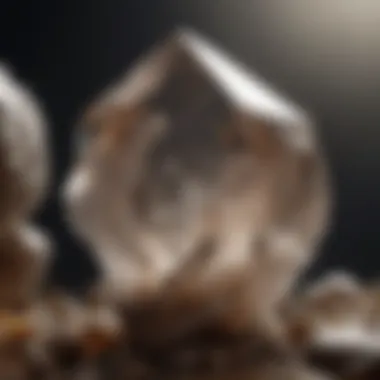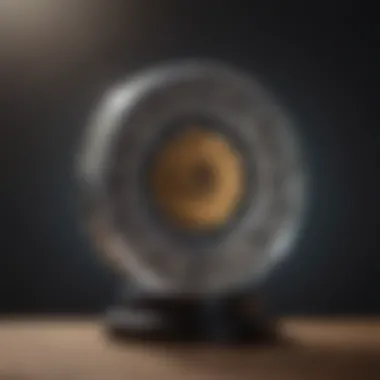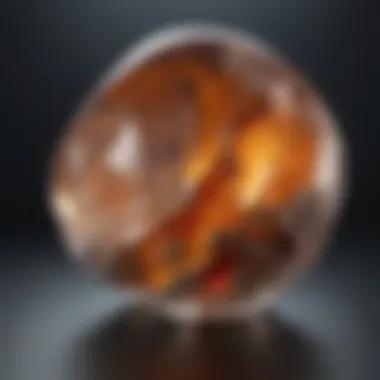Mastering the Art of Quartz Polishing: A Comprehensive Guide for Rock and Fossil Collectors


Rock and Fossil Identification
Rock and fossil identification is a fundamental aspect of the rock and fossil collecting hobby. Understanding the various types of rocks and fossils is crucial for enthusiasts in the field. When embarking on a collecting journey, it is essential to recognize the distinguishing characteristics of different specimens. Tools for identification such as magnifying glasses, UV lights, and hardness testing kits can aid collectors in accurately classifying their finds.
Collecting Tips and Techniques
For rock and fossil collectors, mastering best practices in collecting is key to building a high-quality collection. Locating prime collecting sites involves research and exploration to uncover areas rich in geological treasures. When extracting specimens, it is important to do so safely and responsibly to avoid damaging the surrounding environment and the specimens themselves.
Preservation and Display
Preserving rocks and fossils ensures their longevity and maintains their pristine condition. Utilizing techniques such as cleaning, stabilizing, and protecting specimens from environmental factors is vital for conservation. Proper storage methods involve moisture control and protection from sunlight to prevent deterioration. Creative display ideas can showcase your collection's aesthetic beauty while also providing educational value.
Geological Insights
Delving into the geological aspects of rock and fossil collecting unveils a deeper understanding of Earth's history. Exploring geological formations and processes can illuminate the origins of different rocks and fossils. Understanding the historical significance of certain specimens sheds light on past environments and ecosystems. Notable discoveries in the field have contributed to scientific knowledge and enriched our appreciation for the wonders of the natural world.
Introduction
Quartz polishing is a meticulous art form that requires a keen understanding of the properties of quartz and the right equipment. This guide aims to equip rock and fossil collectors with the knowledge and techniques needed to enhance the beauty of their quartz specimens through expert polishing methods. By delving into the nuances of quartz polishing, enthusiasts can elevate their collection to new levels of elegance and refinement.
Understanding Quartz Polishing
Properties of Quartz
Quartz, a prized mineral known for its durability and clarity, presents unique characteristics that make it a popular choice for polishing. Its hardness, registering 7 on the Mohs scale, ensures that polished quartz surfaces maintain their luster over time. Furthermore, quartz's abundant availability in nature and its diverse range of colors offer collectors endless possibilities in their polishing endeavors. The clarity of quartz allows for intricate polishing techniques, resulting in stunning final products that showcase the brilliance of this mineral.
Benefits of Polishing
Polishing quartz not only enhances its natural beauty but also provides a protective layer that safeguards the specimen from environmental damage. The polished surface of quartz reflects light beautifully, highlighting its internal structures and colors. This visual enhancement makes polished quartz ideal for display in collections, as each piece becomes a captivating focal point. Additionally, the act of polishing quartz can reveal hidden patterns and inclusions within the stone, adding an element of intrigue to the collector's experience.
Equipment Required


In the realm of quartz polishing, the significance of proper equipment cannot be overstated. The tools you use play a crucial role in the final outcome of the polishing process. Having the right equipment not only ensures efficiency but also contributes significantly to the overall quality of the finished product. In this article, we will delve into the essential tools required for quartz polishing, exploring their specific functions and the benefits they offer to rock and fossil collectors looking to enhance the appearance of their specimens.
Essential Tools
Polishing Machine
When it comes to quartz polishing, a polishing machine stands out as a cornerstone tool in achieving expert-level results. The key characteristic of a polishing machine lies in its ability to provide consistent and controlled polishing motions. This machine offers precision and power, making it a popular choice among enthusiasts for its efficiency and effectiveness. The unique feature of a polishing machine is its versatility in handling various types of quartz specimens, allowing for customized polishing techniques. While a polishing machine optimizes the polishing process, it may require some level of expertise to operate effectively, but the advantages it brings to this article in terms of enhancing the final finish are undeniable.
Various Grits of Sandpaper
Another essential tool in quartz polishing is the various grits of sandpaper, each playing a distinct role in the progression of the polishing process. The key characteristic of different grits of sandpaper lies in their abrasive properties, with each grit level targeting specific imperfections on the quartz surface. By using a combination of coarse to fine grits, rock and fossil collectors can achieve a smooth and flawless polish. The versatility and availability of different grits make them a popular choice for this article, ensuring that collectors can tailor their polishing techniques based on the condition of the quartz specimen. However, it is essential to note that using the incorrect grits can lead to subpar results, underscoring the importance of understanding the proper grit sequence.
Polishing Compounds
Polishing compounds play a vital role in enhancing the shine and luster of polished quartz surfaces. The key characteristic of polishing compounds lies in their abrasive and chemical composition, designed to bring out the natural beauty of quartz specimens. These compounds act as the final touch in the polishing process, refining the surface to a brilliant finish. The unique feature of polishing compounds is their ability to remove fine scratches and imperfections, elevating the visual appeal of the quartz. While polishing compounds offer numerous advantages in achieving stunning results, careful application is necessary to avoid overuse, which could potentially damage the polished surface. It is essential to understand the properties of different polishing compounds and choose the appropriate ones based on the specific requirements of the quartz specimen in focus.
Preparation
In the realm of quartz polishing, preparation plays a pivotal role in the quest for achieving flawless results. Ensuring that the quartz is adequately prepped before diving into the polishing process can make a world of difference. The meticulous act of preparing the quartz involves meticulously cleaning the surface to eliminate any potential contaminants or unwanted debris. By eliminating these impurities, the polishing procedure can be executed with precision, allowing the natural beauty of the quartz to shine through effortlessly. Furthermore, proper preparation sets the foundation for a seamless polishing experience, guaranteeing a professional finish that will undoubtedly impress even the most discerning rock and fossil collectors.
Cleaning the Quartz
Removing Dirt and Debris
When it comes to the meticulous task of removing dirt and debris from quartz surfaces, attention to detail is paramount. This step involves carefully scrutinizing the quartz specimen to identify and eliminate any foreign particles that may compromise the polishing process. By meticulously removing dirt and debris, collectors can ensure that the final polished result showcases the true essence of the quartz, devoid of any imperfections. This meticulous process of purging the quartz from unwanted contaminants sets the stage for a successful polishing endeavor, where each stroke of the polishing tool can work its magic unhindered by external intrusions. Embracing this step with diligence and precision is key to unlocking the full potential of the quartz specimen at hand.
Drying Thoroughly
One cannot overstate the significance of drying quartz specimens thoroughly post-cleaning. After meticulously removing dirt and debris, allowing the quartz to dry completely is essential to prevent any water-related imperfections during the polishing phase. Moisture trapped within the quartz can hinder the polishing compounds' efficacy, leading to subpar results. By ensuring that the quartz is dried thoroughly, collectors set the stage for a seamless polishing process that guarantees optimal outcomes. Additionally, a dry quartz surface enables the polishing compounds to adhere effectively, facilitating a smooth and efficient polishing experience. Embracing this meticulous drying process is a fundamental aspect of preparing the quartz for its transformative journey from raw stone to a dazzling polished gem.
Polishing Techniques


The section on Polishing Techniques delves deep into the intricate process of enhancing the beauty of quartz specimens. When it comes to quartz polishing, mastering the techniques is paramount for achieving stunning results. This crucial aspect of the article provides valuable insights into the methodology behind transforming rough quartz into a polished gem. Understanding the nuances of polishing techniques allows rock and fossil collectors to elevate the aesthetics of their specimens, showcasing the inherent beauty of quartz.
Step-by-Step Process
Initial Grinding:
Initiating the polishing journey with the initial grinding stage sets the foundation for a flawless finish. Initial Grinding focuses on shaping the rough quartz surface, smoothing out imperfections, and preparing it for subsequent polishing stages. This integral step ensures that the quartz specimen is adequately prepped to undergo further refinement. The key characteristic of Initial Grinding lies in its ability to remove coarse irregularities, revealing the true potential of the quartz piece. While Initial Grinding may be time-consuming, its meticulous approach yields refined results, making it a favored choice for achieving exceptional polish quality. The unique feature of Initial Grinding is its precision in reshaping the quartz surface, refining it to a state ready for progressive grits and final polishing. Despite being labor-intensive, the advantages of Initial Grinding in this article are undeniable, laying the groundwork for a flawless polishing process.
Progressive Grits:
Transitioning from Initial Grinding to Progressive Grits marks a significant phase in the quartz polishing process. Progressive Grits involve utilizing a series of finer grits to progressively refine the quartz surface, smoothing out any remaining rough patches and enhancing its luster. The key characteristic of Progressive Grits is their incremental approach towards achieving a high-gloss finish, gradually buffing the quartz to perfection. This methodical progression ensures that each grit level contributes to the refinement of the specimen, culminating in a flawlessly polished surface. The unique feature of Progressive Grits is their ability to enhance clarity and shine, bringing out the natural beauty of the quartz while reducing surface scratches. While Progressive Grits demand patience and meticulous attention to detail, their advantages in this article lie in their ability to elevate the final polish quality to a professional standard.
Final Polishing:
The Final Polishing stage signifies the culmination of the quartz polishing journey, offering a mirror-like finish to the specimen. Final Polishing focuses on achieving a smooth, high-gloss surface, refining the quartz to its optimal shine. The key characteristic of Final Polishing is its ability to highlight the inherent beauty of the quartz, showcasing its unique patterns and colors in exquisite detail. Praised for its ability to bring out the full potential of the specimen, Final Polishing is a crucial step for collectors aiming to display their quartz treasures with pride. The unique feature of Final Polishing is its transformative effect, turning a rough stone into a polished gem that captures the light with dazzling brilliance. While Final Polishing requires precision and finesse, its advantages in this article are definitive, delivering breathtaking results that captivate both collectors and admirers alike.
Finishing Touches
In the realm of quartz polishing, the final stages are as crucial as the initial ones, emphasizing the completion of the process with finesse and precision. The section of 'Finishing Touches' within this comprehensive guide plays a pivotal role in elevating the aesthetic appeal and durability of the polished quartz specimens. By focusing on the nuances of buffing and sealing, collectors can achieve a refined and long-lasting finish that showcases the inherent beauty of the quartz.
Buffing and Sealing
Buffing the Surface
Buffing the surface of the polished quartz serves as the ultimate step in refining its appearance, imparting a glossy sheen that enhances its natural allure. The key characteristic of buffing lies in its ability to smoothen out any imperfections and scratches, leaving behind a mirror-like finish that accentuates the quartz's unique patterns and hues. This technique is popular among collectors for its transformative effect, bringing out the full potential of the specimen with minimal effort.
Sealing for Protection
When it comes to preserving the pristine state of the polished quartz, sealing emerges as a vital aspect in prolonging its durability and aesthetic charm. The unique feature of sealing lies in its protective barrier, shielding the surface from potential damage due to environmental factors or handling. By sealing the polished quartz, collectors safeguard their investment, ensuring that the beauty of the specimen remains intact for years to come. While sealing enhances the longevity of the polish, collectors should be aware of the potential challenges, such as choosing the right sealant suitable for the specific type of quartz to avoid altering its natural properties.
Tips for Success


Quartz polishing demands a meticulous approach to achieve the desired results. Understanding the essential tips for success is crucial in this art. Patience and precision play pivotal roles in ensuring a flawless finish on quartz specimens. Maintaining consistent pressure throughout the polishing process is a key factor in achieving smooth and uniform surfaces. By applying even pressure, you can avoid uneven polishing and create a consistent shine across the quartz. Additionally, adhering to expert recommendations and techniques can help novices navigate the intricate process of quartz polishing with confidence and finesse.
Expert Recommendations
Maintaining Consistent Pressure
Maintaining consistent pressure during quartz polishing is fundamental to the process's success. This technique ensures an even distribution of force on the quartz surface, preventing uneven polishing or damage to the specimen. By exerting uniform pressure, collectors can control the rate at which the material is removed, leading to a more controlled and predictable polishing outcome. Consistency in pressure application is key to achieving a smooth, polished finish on quartz specimens, enhancing their aesthetic appeal and overall quality.
Patience in the Polishing Process
Patience is not just a virtue but a necessity in the quartz polishing process. Rushing through the steps can result in subpar polishing outcomes or damage to the specimen. Patience allows the collector to observe the gradual transformation of the quartz, ensuring each stage is completed thoroughly before progressing to the next. It also enables adjustments to be made along the way, ensuring that the final polish meets the desired criteria. Embracing patience in the polishing process yields superior results, showcasing the beauty and luster of the quartz specimens.
Common Mistakes to Avoid
In the realm of quartz polishing, understanding and avoiding common mistakes can significantly impact the outcome of your polishing endeavors. By recognizing and rectifying these errors, enthusiasts can elevate the quality of their final product and ensure a superior finish. One crucial aspect to consider is the meticulous selection of the grits used during the polishing process. Using incorrect grits can lead to subpar results, affecting the overall surface smoothness and shine of the quartz. Additionally, not adhering to proper cleaning steps before polishing can introduce dirt and debris, diminishing the luster of the specimen. In this article, we delve deep into these pitfalls to enlighten rock and fossil collectors on the importance of precision and attention to detail in quartz polishing.
Pitfalls in Quartz Polishing
Using Incorrect Grits:
When it comes to polishing quartz, the choice of grits plays a pivotal role in determining the final outcome. Using incorrect grits can result in uneven surfaces, scratches, or a lackluster shine. It is essential to understand the characteristics of each grit level and their specific purposes in the polishing sequence. Selecting the right grit progression is fundamental for achieving the desired smoothness and polish on the quartz surface. While coarse grits remove imperfections, finer grits refine the finish to a brilliant sheen. Therefore, overlooking the importance of appropriate grit selection can hinder the overall quality of the polishing process in this comprehensive guide.
Overlooking Cleaning Steps:
Another common mistake in quartz polishing is overlooking the crucial cleaning steps before commencing the polishing process. Failure to thoroughly clean the quartz specimen can lead to undesirable outcomes, such as trapped dirt or residue impacting the polishing efficacy. By neglecting this preparatory phase, collectors risk compromising the clarity and brilliance of the final polished product. Emphasizing thorough cleaning practices is paramount to ensure that the quartz surface is devoid of any contaminants that could mar the polishing results. In this article, we shed light on the significance of meticulous cleaning as a foundational step in achieving stunning polished quartz specimens.
Conclusion
In the culmination of this extensive guide on the art of quartz polishing for rock and fossil collectors, it is pivotal to underscore the significance of achieving optimal results in this meticulous process. When it comes to enhancing the beauty and vibrancy of quartz specimens, the conclusion plays a vital role in cementing the efforts invested in the polishing journey. By meticulously following the steps outlined in this guide, enthusiasts can transform ordinary quartz rocks into stunning focal points that exude elegance and artistic allure. Moreover, the conclusion serves as a testament to the dedication and craftsmanship required in elevating quartz specimens to their full potential, making them prime components of any collector's showcase.
Achieving Stunning Results
Admiring the Polished Quartz
Delving into the intricacies of admiring the polished quartz reveals a pivotal aspect of the quartz polishing process. The exquisite finish achieved through meticulous polishing not only enhances the visual appeal of the specimens but also allows collectors to appreciate the inherent beauty and unique qualities of quartz at a heightened level. A key characteristic of admiring the polished quartz is the depth and clarity of the surface, showcasing the natural patterns and hues of the mineral in a captivating manner. This admiration process is not just about visual pleasure but also about gaining a deeper understanding and connection with the geological wonders encapsulated within the quartz specimens. While the process demands patience and precision, the end result of admiring the polished quartz is immensely rewarding, offering a tangible representation of nature's artistry in its purest form.
Showcasing Your Collection
The aspect of showcasing your fine-tuned collection of polished quartz is a culmination of dedication and passion in the realm of rock and fossil collecting. By meticulously curating and presenting the polished specimens, collectors imbue their personal touch and artistic flair into the exhibit, making it a reflection of their unique taste and appreciation for natural beauty. The key characteristic of showcasing the collection lies in the ability to create a harmonious display that highlights the individuality of each quartz specimen while maintaining a cohesive theme that resonates with the collector's aesthetic vision. The act of showcasing goes beyond mere presentation; it is a narrative that encapsulates the journey of exploration, discovery, and transformation involved in the process of quartz polishing. While there are challenges such as preserving the specimens' luster and ensuring aesthetic coherence, the act of showcasing your collection is a fulfilling endeavor that allows collectors to share their passion for geological marvels with others.







